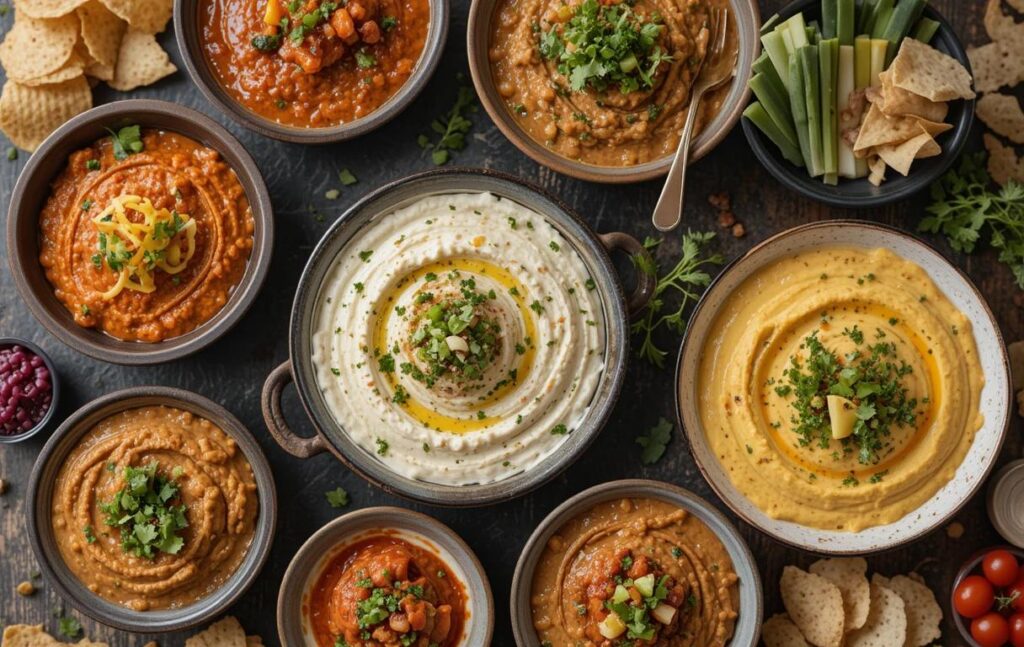How Long to Smoke a Dip? The Perfect Timing for an Unforgettable BBQ
If you’ve ever wondered how long to smoke a dip to achieve that irresistible, smoky goodness, you’re not alone. Smoking dips is a growing culinary trend that elevates simple recipes into unforgettable appetizers or sides. But timing is everything! Whether you’re preparing a creamy cheese dip or a robust bean dip, understanding the smoking process and ideal timing ensures every bite is bursting with flavor.
How long to smoke a dip?
Smoking food is an age-old technique that has gained modern popularity for its ability to infuse dishes with complex, rich flavors. From meats and vegetables to snacks and desserts, the versatility of smoking is impressive—but smoking dips has taken the trend to a new level. Why? Because it combines the creamy, gooey textures we love in dips with a smoky, bold taste that can’t be achieved through traditional baking or stovetop cooking.
Smoking dips is particularly popular for outdoor gatherings, BBQ parties, and tailgates, offering a gourmet twist to classic appetizers. The process is straightforward but requires some attention to detail—most importantly, knowing how long to let your dip soak in the smoky environment. Get it right, and your guests will be asking for your secret recipe!
Understanding the Basics of Smoking Dips
Smoking dips involves more than just tossing your favorite recipe into a smoker. It’s a culinary art that brings out bold, deep flavors while maintaining the creamy or chunky texture that makes dips so satisfying. To master smoking dips, it’s crucial to understand the basics, from the types of dips that work best to the equipment and ingredients required.
Types of Dips Best Suited for Smoking
Not all dips are created equal when it comes to smoking. While most dips can benefit from the process, some shine brighter than others due to their ingredients and structure:
- Cheese-Based Dips
Creamy dips like queso, spinach-artichoke, or pimento cheese are ideal for smoking. The cheese absorbs the smoke beautifully, creating a velvety, rich flavor.
Smoking Time: 30–45 minutes - Bean-Based Dips
Black bean or hummus-style dips gain an earthy, smoky depth that balances their natural richness.
Smoking Time: 45 minutes–1 hour - Veggie and Salsa Dips
Roasted vegetable or chunky salsas absorb lighter smoke for a nuanced taste. Be cautious with time to avoid over-smoking.
Smoking Time: 30 minutes - Layered Dips
Seven-layer or taco dips develop extra layers of flavor with carefully managed smoking time to preserve the distinct textures.
Smoking Time: 20–30 minutes
Common Smoking Equipment Needed
The right tools make all the difference when smoking dips. Here’s what you’ll need:
- Smoker: Choose from pellet smokers, electric smokers, or charcoal smokers depending on your setup.
- Wood Chips: Popular choices include hickory (bold flavor), applewood (mild and sweet), and cherry (subtle fruitiness).
- Heatproof Dishes: Use cast iron skillets or disposable aluminum trays for easy handling and even cooking.
- Thermometer: Helps monitor the smoker temperature, which should ideally stay between 225°F and 250°F.
- Foil or Smoker Lids: To prevent over-smoking, especially for delicate dips.
The Science Behind Smoking Dips
Smoking dips is more than just a cooking method—it’s a chemical transformation that enhances the flavor, texture, and aroma of your dish. Understanding the science behind it helps you perfect your recipe and troubleshoot any issues that might arise.
How Smoke Enhances Flavor
When you place a dip in a smoker, the heat and smoke interact with its surface in unique ways:
- Flavor Compounds in Smoke: Wood chips release natural compounds like guaiacol and syringol, which are responsible for the smoky aroma and taste. These compounds cling to fats and proteins in the dip, intensifying the flavor.
- Mild Caramelization: Smoky heat causes sugars in ingredients like cheese, vegetables, or beans to caramelize lightly, adding depth to the taste.
- Absorption of Aroma: The porous texture of dips, especially creamy or layered ones, traps smoky aromas, giving the dish a multi-dimensional flavor.
Optimal Temperature and Smoke Levels
For the best results, maintaining a consistent temperature and smoke density is critical.
- Ideal Temperature Range
- Aim for a smoker temperature between 225°F and 250°F. This range allows the dip to cook evenly without drying out or becoming overly smoky.
- Keep a thermometer handy to monitor temperature fluctuations, especially if you’re using a charcoal smoker.
- Smoke Levels
- Avoid “thick white smoke,” as it can overpower the dip and create bitter flavors.
- Strive for “thin blue smoke,” which signals clean-burning wood and optimal flavor infusion.
Wood Chip Varieties for Smoking Dips
The type of wood you use can drastically alter the flavor of your smoked dip. Here’s a breakdown of popular wood chips and their profiles:
- Hickory: Strong and bold, pairs well with cheese-based dips.
- Applewood: Mildly sweet, great for veggie or fruit-based dips.
- Cherrywood: Subtle and fruity, adds a gentle smoke to lighter dips.
- Mesquite: Intense and earthy, use sparingly for robust dips like black bean.
Pro Tip: Mix two wood types, like hickory and applewood, to create a balanced flavor profile.
How Long to Smoke a Dip? Timing Guidelines

The duration of smoking is one of the most critical factors in achieving a perfect smoked dip. Smoke it for too long, and it may taste bitter or overly intense. Smoke it too briefly, and you won’t get that deep, rich flavor you’re aiming for. In this section, we’ll break down the timing for different dips and highlight factors that influence smoking duration.
General Timing for Smoking Dips
The smoking time for dips typically ranges from 20 minutes to 1 hour, depending on the type of dip and its ingredients. Here are some general guidelines:
- Cheese-Based Dips: 30–45 minutes
Cheesy dips like queso or spinach-artichoke need enough time to melt and absorb smoke without becoming overly runny. - Bean-Based Dips: 45 minutes–1 hour
Black bean or chickpea dips require more time for the smoke to penetrate their denser texture. - Vegetable and Salsa Dips: 20–30 minutes
These dips have lighter textures and don’t need extensive smoking to achieve a balanced flavor. - Layered Dips: 20–30 minutes
Shorter smoking times help preserve the distinct layers while adding a subtle smoky aroma.
Factors Affecting Smoking Time
- Dip Thickness and Size
- Thicker dips or larger quantities may require more time to heat evenly and absorb smoke. Spread dips thinly in a shallow dish to reduce cooking time.
- Smoker Type
- Pellet Smokers: Provide consistent heat and work well for all dips.
- Charcoal Smokers: Require more monitoring to maintain steady temperatures.
- Electric Smokers: Ideal for beginners due to automated controls.
- Wood Type and Flavor Intensity
- Stronger woods like hickory or mesquite can shorten the smoking time needed to achieve a noticeable flavor. Lighter woods like apple or cherry may require the full duration.
- Desired Flavor Level
- For a subtle smoky taste, smoke the dip on the lower end of the time range. For a stronger flavor, extend the duration slightly, but monitor to avoid overpowering bitterness.
Timing Tips for Popular Dips
| Type of Dip | Smoking Time | Temperature |
|---|---|---|
| Cheese-Based Dips | 30–45 minutes | 225°F–250°F |
| Bean-Based Dips | 45 minutes–1 hr | 225°F–250°F |
| Veggie/Salsa Dips | 20–30 minutes | 225°F–250°F |
| Layered Dips | 20–30 minutes | 225°F–250°F |
Pro Tip: Always preheat your smoker for at least 10–15 minutes before placing your dip inside.
Tips for Achieving the Perfect Smoked Dip
Creating the ideal smoked dip requires more than just following the timing guidelines—it’s about fine-tuning your preparation, monitoring, and finishing touches to ensure every bite delivers smoky, creamy goodness. Use these expert tips to elevate your smoked dip game.
Pre-Smoking Preparation
- Select the Right Ingredients
- Use high-quality cheeses, fresh vegetables, and flavorful spices for a strong base.
- Ensure ingredients are evenly chopped or shredded to promote uniform cooking and smoking.
- Choose the Right Dish
- Use a shallow, heatproof dish like a cast iron skillet or aluminum tray to allow maximum smoke exposure.
- Avoid deep dishes, as they can prevent the smoke from evenly penetrating the dip.
- Prepare the Smoker
- Preheat your smoker to the optimal range of 225°F–250°F.
- Add your chosen wood chips (e.g., hickory, applewood) to the smoker before placing the dip.
Pro Tip: Lightly grease your dish or use parchment paper to prevent sticking.
Monitoring the Smoking Process
- Avoid Over-Smoking
- Over-smoking can make your dip taste bitter. Keep an eye on the smoke—it should be light and wispy, not dense.
- If the flavor becomes too intense, consider covering the dip with foil halfway through the smoking process.
- Rotate for Even Cooking
- If your smoker has hot spots, rotate the dish halfway through to ensure even cooking.
- Check for Doneness
- Dips like queso should be bubbly and creamy, while bean dips should have a slightly thickened consistency.
- Avoid frequent opening of the smoker, as this lets out heat and smoke, disrupting the process.
Post-Smoking Techniques for Maximum Flavor
- Cool Before Serving
- Allow the dip to rest for 5–10 minutes after removing it from the smoker. This helps the flavors meld and prevents burns.
- Garnish for Extra Flavor
- Add fresh herbs, a drizzle of olive oil, or a sprinkle of smoked paprika for a finishing touch.
- Serve with the Right Pairings
- Smoked dips pair beautifully with crusty bread, tortilla chips, or fresh vegetables like celery and carrots.
Bonus Tip: Experiment with Add-Ons
- For an extra smoky kick, mix smoked meats like pulled pork or bacon into your dip before placing it in the smoker.
- Add a layer of shredded cheese or breadcrumbs on top for a crisp, golden finish.
Common Mistakes to Avoid When Smoking Dips

Even experienced cooks can encounter challenges when smoking dips. Avoid these common pitfalls to ensure your smoked dip turns out perfect every time.
Over-Smoking the Dip
- One of the most frequent errors is allowing the dip to absorb too much smoke, resulting in a bitter flavor.
- Solution: Monitor the smoker and aim for light, clean smoke rather than thick, billowing clouds.
Using the Wrong Wood Chips
- Choosing an overly strong wood like mesquite for delicate dips can overwhelm their flavor.
- Solution: Stick to mild woods like applewood or cherry for a balanced taste, especially for cheese or vegetable dips.
Smoking at the Wrong Temperature
- Smoking at a temperature that’s too high can cause the dip to overcook, while too low can result in uneven smoking.
- Solution: Maintain a steady range of 225°F–250°F with the help of a smoker thermometer.
Not Preparing Ingredients Properly
- Large, uneven chunks of cheese or vegetables may not heat or absorb smoke evenly.
- Solution: Finely chop or shred ingredients to ensure consistency.
Skipping Preheating or Overlooking Timing
- A cold smoker or rushing the process can lead to poor results.
- Solution: Preheat the smoker for at least 10–15 minutes and follow timing guidelines based on your dip type.
FAQs About Smoking Dips
1. Can I smoke a store-bought dip?
Yes! Store-bought dips like queso or hummus can be enhanced by smoking. Simply transfer the dip to a heatproof dish and follow the smoking instructions for your desired flavor intensity.
2. Do I need to stir the dip while it’s smoking?
No, stirring isn’t necessary. Letting the dip remain undisturbed ensures it develops a uniform smoky crust on top.
3. Can I use a gas grill instead of a smoker?
Yes, you can convert a gas grill into a smoker by using a smoker box filled with wood chips and maintaining a low temperature.
4. What’s the best way to reheat a smoked dip?
Reheat in the oven at 300°F or on a grill with indirect heat. Avoid using the microwave, as it can ruin the texture.
5. How do I fix a dip that’s too smoky?
Mix in fresh ingredients like sour cream, cream cheese, or mashed beans to balance out the flavor.
6. Can I make a smoked dip ahead of time?
Absolutely! Smoked dips can be made a day ahead. Store them in the refrigerator, then reheat gently before serving.
Conclusion: Perfecting the Art of Smoked Dips
Smoking dips is a delicious way to take your favorite appetizers to the next level. By understanding the optimal timing, selecting the right ingredients, and avoiding common mistakes, you’ll create mouthwatering dishes that leave your guests wanting more. Don’t be afraid to experiment with different wood chips, recipes, and add-ons to discover your signature smoked dip. Fire up your smoker, and let the smoky magic begin!
Tasty Taco Bean Dip
Related Recipes
- “Tuna Tomato Sauce Pasta Recipe“: A tomato-based recipe showcasing another way to use tomatoes.
- “Baked Chicken Fettuccine Alfredo with Broccoli“: Another comforting dish that can be complemented with tomato-based sauces.
Ingredient-Focused Content
- “Lions Mane Mushroom Recipe“: Suggest using a tomato gravy as a flavorful addition for plant-based dishes.
Cooking Techniques and Enhancements
- “Mango Habanero Salsa“: Explore complementary uses of sauces and gravies for flavor diversity.
Storage and Reuse Tips
- “Sous Vide Recipes“: Recommend tomato gravy as a sauce for sous vide-cooked meats or vegetables.
- “Ocean Spray Cranberry Sauce Recipe“: Guide readers on making and storing sauces, including tomato gravy.

